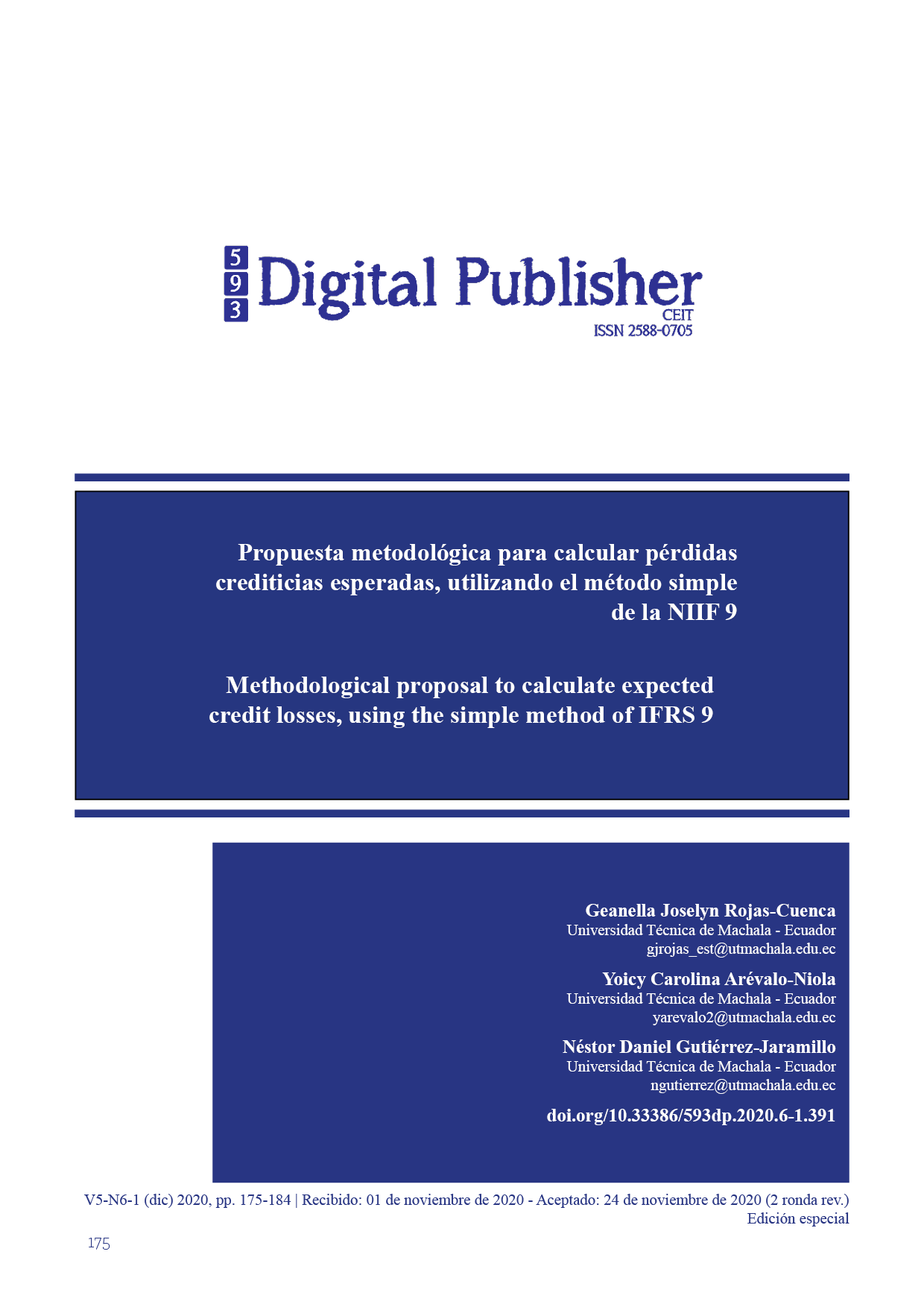Methodological proposal to calculate expected credit losses, using the simple method of IFRS 9
Main Article Content
Abstract
The objective of this research is to propose a methodology tool that allows the credit calculation of expected losses, through the use of the simple method, providing micro-enterprises with an information analysis instrument that allows the Management to carry out efficient financial planning. The study is cross-sectional, taking information from internal secondary sources within the time period of 2019. The method established in the case is composed of a qualitative approach, in the first instance the data of a primary and secondary nature are analyzed to generate a construction according to the theoretical framework; With this reasoning, an interview sheet applied to those in charge of the accounting area was selected. The investigative findings show that the automotive sector is made up of micro-businesses that, for the most part, do not have proper planning, the degree of application and knowledge of IFRS 9 is lacking, because there is no precise measurement and evaluation. of credit losses that are granted through a credit line to the client portfolio. The methodological proposal was adapted to the automotive parts sales industry, and also aims to be a support for the systematic improvement in the accounting and financial performance of the collections department.
Downloads
Article Details

This work is licensed under a Creative Commons Attribution-NonCommercial-ShareAlike 4.0 International License.
1. Derechos de autor
Las obras que se publican en 593 Digital Publisher CEIT están sujetas a los siguientes términos:
1.1. 593 Digital Publisher CEIT, conserva los derechos patrimoniales (copyright) de las obras publicadas, favorece y permite la reutilización de las mismas bajo la licencia Licencia Creative Commons 4.0 de Reconocimiento-NoComercial-CompartirIgual 4.0, por lo cual se pueden copiar, usar, difundir, transmitir y exponer públicamente, siempre que:
1.1.a. Se cite la autoría y fuente original de su publicación (revista, editorial, URL).
1.1.b. No se usen para fines comerciales u onerosos.
1.1.c. Se mencione la existencia y especificaciones de esta licencia de uso.
References
Arias, B. M. (29 de Septiembre de 2020). Legis Comunidad Contable. Obtenido de Legis Comunidad Contable: http://www.comunidadcontable.com/BancoConocimiento/C/contrapartida_933/contrapartida_933.asp?
Autoridad de Supervisión del Sistema Financiero. (s.f.). Riesgo Crediticio de la Recopilación de Normas de ASFI. Artículo 3, Capítulo I, Sección I, Título II .
Benassini, M. (2009). Introducción a la Investigación De Mercados: Enfoque Para América Latina. México D.F: Pearson Educación.
Bernal, C. A. (2010). Metodología de la investigación (Tercera ed.). Bogotá: Pearson Educación.
Deloitte. (2016). NIIF 9 Instrumentos Financieros. Lo que hay que saber desde la perspectiva de las empresas no financieras. Mantente actualizado, 1-33. Obtenido de https://www2.deloitte.com/content/dam/Deloitte/es/Documents/auditoria/Deloitte-ES-Auditoria-niif9.pdf
Gootkind, C. (2013). Alternative Asset Valuation and Fixed Income. CFA® Institute Ed. Boston: Pearson Custom Publishing.
IASB. (2014). Norma Internacional de Información Financiera 9: Instrumentos Financieros. IFRS Foundation. Obtenido de https://www.mef.gob.pe/contenidos/conta_publ/con_nor_co/vigentes/niif/NIIF9_2014_v12112014.pdf
IFRS. (s.f.). Covid-19 y la Fundación IFRS. Obtenido de Covid-19 y la Fundación IFRS: https://www.ifrs.org/
Iñiguez, L. A., Narváez, Z. C., & Erazo, Á. J. (2020). Impacto de las Normas Internacionales de Información Financiera en las Unidades Educativas Particulares. Revista Arbitrada Interdisciplinaria Koinonía, 5(10), 126-159. Obtenido de https://dialnet.unirioja.es/servlet/articulo?codigo=7439101
Latorre, A. F. (2016). Estado del Arte de la Contabilidad de Costos. Revista Publicando, 3(8), 513-528. Obtenido de https://dialnet.unirioja.es/servlet/articulo?codigo=5833423
Moreno, I. d., Mesa, R. B., Sánchez, H. M., & Ramírez, S. J. (2014). El papel de la contabilidad ante la crisis financiera. Una reflexión sobre el conservadurismo incondicional de la NIIF 9. Cuadernos de Contabilidad, 15(38), 371-395. Obtenido de https://dialnet.unirioja.es/servlet/articulo?codigo=5447019
Orobio, M. A., & Rodríguez, R. E. (2018). Análisis del impacto de implementación de las normas internacionales de información financiera (NIIF) en el sector industrial de Bogotá para PYMEs. Cuadernos de Contabilidad, 19(48), 1-18. Obtenido de https://dialnet.unirioja.es/servlet/articulo?codigo=6861104
Parra, D. (07 de Octubre de 2020). Análisis de la aplicación de las NIIF en las pymes de la ciudad de cuenca: Percepción, causas e impacto. Obtenido de dspace: https://dspace.ups.edu.ec/bitstream/123456789/12722/1/UPS-CT006595.pdf
Parrales, C. C., & Castillo, L. F. (2018). Análisis de NIIF 9 - Instrumentos Financieros desde una perspectiva industrial. Contabilidad y Negocios, 13(25), 1-15. doi:https://doi.org/10.18800/contabilidad.201801.001
Rodríguez, D. D. (2017). Antes NIC 39 ahora NIIF 9: nuevos desafíos para los contadores. Contabilidad y Negocios, 12(23), 6-21. Obtenido de https://www.redalyc.org/articulo.oa?id=281653630002
Sampieri, R., Fernández, C. C., & Baptista, L. M. (2010). Metodología de la investigación. México D.F. : Mcgraw-Hill.
SBEF. (2008). Guías para la Gestión de Riesgos . La Paz: Intendencia de Estudios y Normas. Obtenido de https://www.asfi.gob.bo/images/ASFI/DOCS/LIBROS/GuiasRiesgos.pdf
Sosa, M. E. (2016). La hibridación de modelos para la medición de activos según las Normas Internacionales de Información Financiera (NIIF). TEC Empresarial, 10(2), 29-40. Obtenido de https://dialnet.unirioja.es/servlet/articulo?codigo=5604237
Zambrano, M. S. (2010). Obligación de aplicar las Niff en el Ecuador. ECA Sinergia, 1(1), 8-9. Obtenido de https://dialnet.unirioja.es/servlet/articulo?codigo=6197537




